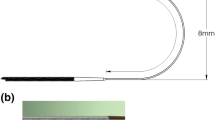Abstract
Introduction
An increasing number of patients undergo left atrial ablation procedures, since several approaches have proven efficacy in the treatment of atrial fibrillation. Although transseptal catheterization was generally shown be a safe technique, it harbors the principal risk of cardiac injury. Therefore, there is a need for a safe and effective tool to enable transseptal puncture in difficult cases as well.
Methods and Results
In 158 consecutive patients, a transseptal puncture was intended for mapping and ablation of left atrial tachycardias. In seven patients of this series transseptal puncture using different sheaths and needle designs, the operators failed to cross the interatrial septum as a result of severe tenting. Three patients were known to have a septal aneurysm; a redo procedure was performed in two patients. In the remaining patients, there was no obvious explanation for the difficulty in crossing the interatrial septum conventionally. In all seven patients, a 120-cm-long nitinol guidewire (“needle wire”) with a 0.014-inch diameter was used to cross the atrial septum with the following idea: after tenting the fossa ovalis with the transseptal dilator and the Brockenbrough needle positioned just inside the tip, effortless advancement of the needle wire perforates the membranous fossa. Unsupported by the needle and dilator, the tip of the wire immediately assumes a “J” shape, rendering it incapable of further tissue penetration after its entry into the left atrium. In all seven patients, the needle wire could be placed into a left pulmonary vein. In five patients, a single attempt was sufficient to reach the left atrium with the wire, two patients needed two and three attempts, respectively. No complications occurred.
Conclusions
Additional use of a needle wire to perform transseptal puncture in a subset of patients at higher risk for complications appears safe and effective.


Similar content being viewed by others
References
Ross, J., Jr., Braunwald, E., & Morrow, A. G. (1959). Transseptal left atrial puncture; new technique for the measurement of left atrial pressure in man. American Journal of Cardiology, 3, 653–655.
Haissaguerre, M., Shah, D. C., Jais, P., Hocini, M., Yamane, T., Deisenhofer, I., et al. (2000). Electrophysiological breakthroughs from the left atrium to the pulmonary veins. Circulation, 102, 2463–2465.
Cappato, R., Calkins, H., Chen, S. A., Davies, W., Iesaka, Y., Kalman, J., et al. (2005). Worldwide survey on the methods, efficacy, and safety of catheter ablation for human atrial fibrillation. Circulation, 111, 1100–1105.
De Ponti, R., Cappato, R., Curnis, A., Della, B. P., Padeletti, L., Raviele, A., et al. (2006). Trans-septal catheterization in the electrophysiology laboratory: data from a multicenter survey spanning 12 years. Journal of the American College of Cardiology, 47, 1037–1042.
Fagundes, R. L., Mantica, M., De Luca, L., Forleo, G., Pappalardo, A., Avella, A., et al. (2007). Safety of single transseptal puncture for ablation of atrial fibrillation: retrospective study from a large cohort of patients. Journal of Cardiovascular Electrophysiology, 18, 1277–1281.
Marcus, G. M., Ren, X., Tseng, Z. H., Badhwar, N., Lee, B. K., Lee, R. J., et al. (2007). Repeat transseptal catheterization after ablation for atrial fibrillation. Journal of Cardiovascular Electrophysiology, 18, 55–59.
Tomlinson, D. R., Sabharwal, N., Bashir, Y., & Betts, T. R. (2008). Interatrial septum thickness and difficulty with transseptal puncture during redo catheter ablation of atrial fibrillation. Pacing and Clinical Electrophysiology, 31, 1606–1611.
Hu, Y. F., Tai, C. T., Lin, Y. J., Chang, S. L., Lo, L. W., Wongcharoen, W., et al. (2008). The change in the fluoroscopy-guided transseptal puncture site and difficult punctures in catheter ablation of recurrent atrial fibrillation. Europace, 10, 276–279.
Bidart, C., Vaseghi, M., Cesario, D. A., Mahajan, A., Fujimura, O., Boyle, N. G., et al. (2007). Radiofrequency current delivery via transseptal needle to facilitate septal puncture. Heart Rhythm, 4, 1573–1576.
Casella, M., Dello, R. A., Pelargonio, G., Martino, A., De Paulis, S., Zecchi, P., et al. (2008). Fossa ovalis radiofrequency perforation in a difficult case of conventional transseptal puncture for atrial fibrillation ablation. Journal of Interventional Cardiac Electrophysiology, 21, 249–253.
Sakata, Y., & Feldman, T. (2005). Transcatheter creation of atrial septal perforation using a radiofrequency transseptal system: novel approach as an alternative to transseptal needle puncture. Catheter Cardiovasc Interv, 64, 327–332.
Hildick-Smith, D., McCready, J., & de Giovanni, J. (2007). Transseptal puncture: use of an angioplasty guidewire for enhanced safety. Catheterization and Cardiovascular Interventions, 69, 519–521.
Hanaoka, T., Suyama, K., Taguchi, A., Shimizu, W., Kurita, T., Aihara, N., et al. (2003). Shifting of puncture site in the fossa ovalis during radiofrequency catheter ablation: intracardiac echocardiography-guided transseptal left heart catheterization. Japanese Heart Journal, 44, 673–680.
Saliba, W., & Thomas, J. (2008). Intracardiac echocardiography during catheter ablation of atrial fibrillation. Europace, 10(Suppl 3), iii42–iii47.
Author information
Authors and Affiliations
Corresponding author
Rights and permissions
About this article
Cite this article
Wieczorek, M., Hoeltgen, R., Akin, E. et al. Use of a novel needle wire in patients undergoing transseptal puncture associated with severe septal tenting. J Interv Card Electrophysiol 27, 9–13 (2010). https://doi.org/10.1007/s10840-009-9460-1
Received:
Accepted:
Published:
Issue Date:
DOI: https://doi.org/10.1007/s10840-009-9460-1




